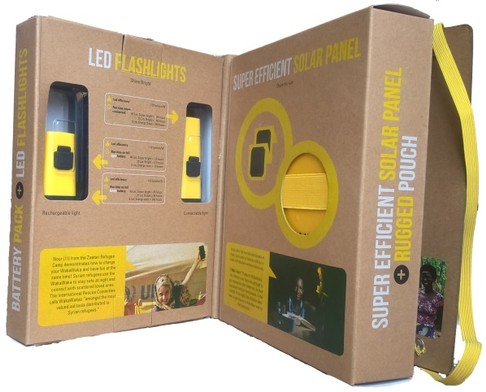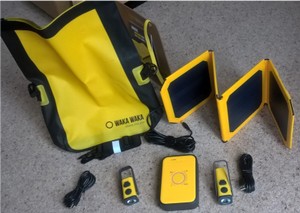Peter's Place - Summer 17 - Fascinating Tech Magazine Archivee
Main menu:
Peter's Place - Summer 17
Archived Issues > Summer 2017 Issue
PETER'S
PLACE

Review of the WAKA
WAKA Portable Solar Power Kit
The Base 10 is a compact portable
solar power kit that can recharge mobile phones and also provide light.
 In
the box are the following items:
In
the box are the following items:a)
10W solar panel made up of four linked 2.5W panels.
b)
10,000mAh Battery Pack that can be charged by either the solar panel or mains
power.
c)
Two lights, one with a rechargeable battery and the other which only operates
when connected to the battery pack.
d)
Two USB connecting cables.
e)
Waterproof bag.
Solar Panel
The
solar panel is of a compact design but to get the highest charging rate it does
require careful alignment to the sun. In practice it needs some method of
keeping the four panels aligned in the same flat plane during solar charging.
The connecting cable to the battery pack is of a good length so that the solar
panel can be placed outside e.g. on the roof of a car, while the battery pack
is locked securely inside the vehicle.
 Battery Pack
Battery PackCharging
of the battery pack can be done using mains or solar power. USB sockets are
provided to allow the simultaneous charging of multiple devices. One port is said
to be optimised for Apple devices and another dedicated to the lights. A button
in the centre of the battery pack allows the charged state of the battery to be
seen and will also indicate the level of charge being received from the solar
panel.
The
battery pack comes with a protective water resistant rubberized five-sided
shell.
Lights
Two
LED flashlights are included, one rechargeable and the other which operates
when connected to the battery pack. The lights have two brightness settings
plus an SOS mode. Up to eight lights can be connected together to extend the
area that can be illuminated.
Summary
All
of the components provided in the Base 10 unit are rugged, well made and should
withstand a portable lifestyle. Features that could stand some improvement are
the carry bag which needs some internal pockets to stow the various items safely
and a more waterproof means of closure. Some indication of charge level on the
rechargeable flashlight would be useful, and the instruction manual could stand
some improvement.
The
unit operates well in a static location where the solar panel can be held flat,
at the correct angle to the sun and left for the day to charge the battery
pack. The base 10 is currently successfully used in refugee camps to charge
mobile phones and in emergency kits for hurricane areas.
It
has been suggested that the kit could be used by hikers in remote areas to
recharge navigation devices etc. but with many hikers keeping the weight that
they carry to a minimum the additional weight of the unit, in excess of 3Kg may
deter potential users. It does seem that the amount to which the solar panel
could charge the battery while carried on the outside of a pack would be very
limited given that the panel will rarely be correctly orientated to the sun. My colleague Richard will be doing a long term test of the usability with a report in the next issue.
Every time a WakaWaka
product is sold, a donation will be given to the WakaWaka Foundation which
raises funds to provide solar products to families in humanitarian crises and
improve the access to safe and sustainable solar in rural communities.
Garry follows up on last issues Energenie and Wolet reviews. He also looks at some fantastic Edifier Speakers | Ruth is back this issue and looks at the Huawei Watch 2, Acer Chromebook and a great STM Bag | |||
A Video Editing review special, a Virtual space visit and a special day out with Acer | Peter harnesses the Sun's energy | Back to the cover |